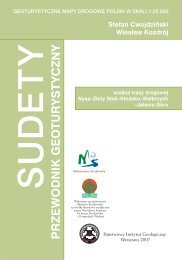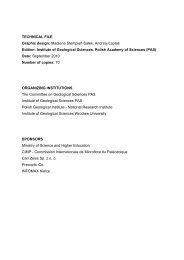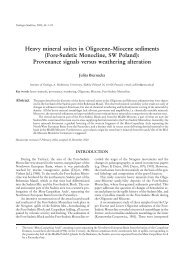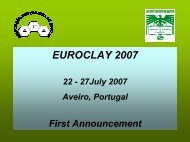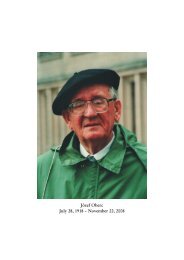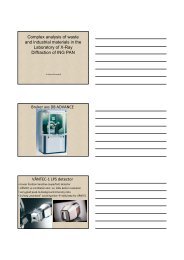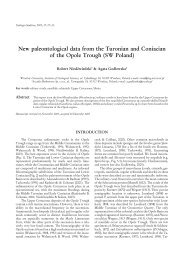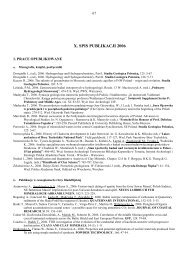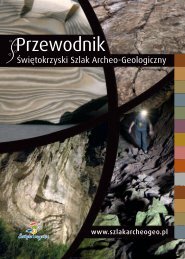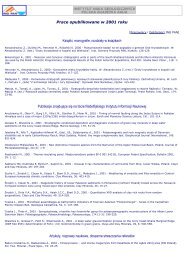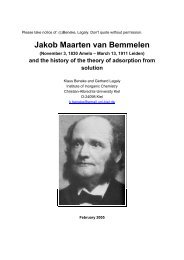Clay Mineral Laboratory of INGPAN in Kraków: research area ...
Clay Mineral Laboratory of INGPAN in Kraków: research area ...
Clay Mineral Laboratory of INGPAN in Kraków: research area ...
Create successful ePaper yourself
Turn your PDF publications into a flip-book with our unique Google optimized e-Paper software.
<strong>Clay</strong> <strong>M<strong>in</strong>eral</strong> <strong>Laboratory</strong> <strong>of</strong> <strong>INGPAN</strong><br />
<strong>in</strong> Kraków:<br />
<strong>research</strong> <strong>area</strong>, analytical procedures,<br />
and applications <strong>in</strong> oil <strong>in</strong>dustry<br />
Jan Środoń<br />
Institute <strong>of</strong> Geological Sciences PAN, Senacka 1,<br />
31002 Kraków, Poland, ndsrodon@cyf-kr-edu.pl<br />
Science for Industry, <strong>INGPAN</strong>, Warszawa,<br />
20-22.06.2012<br />
Research Centre ING PAN <strong>in</strong> Kraków<br />
head: Jan Środoń; secretariat: Aleksandra Mizerska<br />
ndmizers@cyf-kr.edu.pl<br />
<strong>Clay</strong> Lab<br />
1
<strong>Clay</strong> <strong>M<strong>in</strong>eral</strong>ogy Lab - staff<br />
• Jan Środoń (head) ndsrodon@cyf-kr.edu.pl (clays <strong>in</strong> oil <strong>in</strong>dustry, thermal<br />
history <strong>of</strong> sedimentary bas<strong>in</strong>s, K-Ar dat<strong>in</strong>g <strong>of</strong> clays, m<strong>in</strong>eralogy <strong>of</strong> illite,<br />
XRD quantitative m<strong>in</strong>eral analysis <strong>of</strong> sedimetary rocks, budget <strong>of</strong> N and B <strong>in</strong><br />
litosphere)<br />
• Arkadiusz Derkowski ndderkow@cyf-kr.edu.pl (clays <strong>in</strong> oil <strong>in</strong>dustry <strong>in</strong>cl.<br />
clays and shale gas, clay dehydroxylation and rehydroxylatioon, K-Ar<br />
dat<strong>in</strong>g, Ediacaran environment, quantitative m<strong>in</strong>eralogy <strong>of</strong> sedimetary rocks)<br />
• Marek Szczerba ndszczer@cyf-kr.edu.pl (molecular model<strong>in</strong>g <strong>of</strong> clay<br />
surface <strong>in</strong>teractions, computer model<strong>in</strong>g <strong>of</strong> experimental data, K-Ar dat<strong>in</strong>g<br />
<strong>of</strong> clays)<br />
• Artur Kuglisiewicz (PhD student: gas shales <strong>in</strong> Poland)<br />
• Tomasz Topór (PhD student: gas shales <strong>in</strong> Poland)<br />
• Tadeusz Kawiak (XRD measurements and quantitative analysis)<br />
• Michał Banaś (K-Ar measurements)<br />
• Małgorzata Zielińska (clay separation)<br />
• Dorota Bakowska (chemical analysis)<br />
<strong>Clay</strong> <strong>M<strong>in</strong>eral</strong>ogy Lab - equipment<br />
• XRD (Thermo X’TRA and old Philips powder diffractometers, Bruker<br />
<strong>in</strong>strument with high-temperature camera to be <strong>in</strong>stalled <strong>in</strong> 2012):<br />
quantitative analysis <strong>of</strong> rock m<strong>in</strong>eral composition, identification <strong>of</strong><br />
mixed-layer clay m<strong>in</strong>erals<br />
• K-Ar (glass extraction l<strong>in</strong>e + MS20 spectrometer, new equipment <strong>in</strong><br />
2012): K-Ar dat<strong>in</strong>g <strong>of</strong> clays older than Pliocene (extension to Ar-Ar and<br />
noble gases and He isotopes expected <strong>in</strong> 2013)<br />
• Thermogravimetry+mass spectrometry+FTIR (under construction,<br />
f<strong>in</strong>anced by ATLAB EU FP7): studies <strong>of</strong> dehydroxylation and<br />
rehydroxylation <strong>of</strong> clays and adsorption <strong>of</strong> other molecules on clay<br />
surfaces, very precise measurements <strong>of</strong> rock porosity<br />
• <strong>Clay</strong> separation (centrifuges, ultrasonic equipment, freeze-dry<strong>in</strong>g etc.):<br />
separation <strong>of</strong> clay fractions from rocks down to
<strong>Clay</strong> <strong>M<strong>in</strong>eral</strong>ogy Lab – standard<br />
procedures for the bulk rock<br />
• Pulveriz<strong>in</strong>g and splitt<strong>in</strong>g rock powders<br />
• Mill<strong>in</strong>g <strong>in</strong> McCrone Mill with ZnO <strong>in</strong>ternal standard<br />
• XRD patterns <strong>of</strong> random preparations <strong>in</strong> 2-65 o 2θ range<br />
• <strong>M<strong>in</strong>eral</strong> identification and quantification <strong>in</strong> the bulk rock<br />
• CEC (Co-hexam<strong>in</strong>e) and TSSA (EGME) <strong>of</strong> the bulk rock<br />
• Porosity <strong>of</strong> gas shales (under development)<br />
• Calculation <strong>of</strong> petrophysical and logg<strong>in</strong>g parameters from above data<br />
comb<strong>in</strong>ed with chemical analyses<br />
<strong>Clay</strong> <strong>M<strong>in</strong>eral</strong>ogy Lab – standard<br />
procedures for clay fractions<br />
• Jackson chemical treatment and centrifuge separation <strong>of</strong> 2-0.2 and
<strong>Clay</strong> <strong>M<strong>in</strong>eral</strong>ogy Lab – examples <strong>of</strong> cooperation<br />
with oil <strong>in</strong>dustry (Chevron)<br />
• QUANTA: computer program for quantitative m<strong>in</strong>eral analysis <strong>of</strong><br />
rocks conta<strong>in</strong><strong>in</strong>g clays<br />
• BESTMIN and BESTROCK: computer programs for calculat<strong>in</strong>g<br />
petrophysical and logg<strong>in</strong>g parameters <strong>of</strong> rocks from m<strong>in</strong>eral and<br />
chemical data<br />
• Precise thermogravimetric method for measur<strong>in</strong>g gas shale porosity<br />
from water saturation<br />
<strong>Clay</strong> <strong>M<strong>in</strong>eral</strong>ogy Lab – examples <strong>of</strong> applications<br />
<strong>in</strong> borehole geophysics<br />
MINERAL COMPOSITIONAL TRENDS AND THEIR CORRELATIONS WITH<br />
PETROPHYSICAL AND WELL-LOGGING PARAMETERS REVEALED BY QUANTA +<br />
BESTMIN ANALYSIS: MIOCENE OF THE CARPATHIAN FOREDEEP, POLAND<br />
JAN ŚRODOŃ AND TADEUSZ KAWIAK<br />
Institute <strong>of</strong> Geological Sciences PAN, Senacka 1, 31002 Krakow, Poland<br />
<strong>Clay</strong>s and <strong>Clay</strong> <strong>M<strong>in</strong>eral</strong>s, 60, 63–75, 2012.<br />
Sieć naukowa<br />
„Metody Jądrowe<br />
dla Ge<strong>of</strong>izyki”<br />
<strong>Clay</strong> <strong>M<strong>in</strong>eral</strong>ogy Lab – examples <strong>of</strong> applications<br />
<strong>in</strong> borehole geophysics<br />
8<br />
9<br />
gra<strong>in</strong> density Bestm<strong>in</strong><br />
2.780<br />
2.760<br />
2.740<br />
2.720<br />
2.700<br />
2.680<br />
2.660<br />
2.640<br />
0.0 10.0 20.0 30.0 40.0 50.0<br />
%2:1 + 0.31*%Calcite<br />
% 2:1<br />
50.00<br />
y = 1.6076x - 12.546<br />
40.00<br />
R 2 = 0.9327<br />
30.00<br />
20.00<br />
10.00<br />
0.00<br />
5.00 10.00 15.00 20.00 25.00 30.00 35.00<br />
neutron absorption cross section Σa<br />
10<br />
6<br />
% Calcite<br />
100.00<br />
80.00<br />
60.00<br />
40.00<br />
20.00<br />
y = 0.0149x 2 + 1.1754x + 0.0893<br />
R 2 = 0.9931<br />
Porosity measured<br />
35<br />
30<br />
25<br />
20<br />
15<br />
10<br />
y = 1.0608x - 1.4669<br />
R 2 = 0.9817<br />
0.00<br />
0 10 20 30 40 50<br />
CaO<br />
5<br />
5.00 10.00 15.00 20.00 25.00 30.00 35.00<br />
Porosity Bestm<strong>in</strong><br />
4
<strong>Clay</strong> <strong>M<strong>in</strong>eral</strong>ogy Lab – examples <strong>of</strong> applications<br />
<strong>in</strong> borehole geophysics<br />
CEC<br />
15<br />
30.00<br />
y = 0.0221x 2 + 0.1753x - 2.7982<br />
25.00<br />
R 2 = 0.9618<br />
20.00<br />
15.00<br />
10.00<br />
5.00<br />
0.00<br />
5.00 10.00 15.00 20.00 25.00 30.00 35.00<br />
neutron absorption cross section Σa<br />
CEC calculated from Σa<br />
30.00<br />
y = 0.962x + 0.4307<br />
25.00<br />
R 2 = 0.9618<br />
20.00<br />
15.00<br />
10.00<br />
5.00<br />
0.00<br />
0.00 5.00 10.00 15.00 20.00 25.00 30.00<br />
CEC measured<br />
CEC + ρ ma Q v<br />
<strong>in</strong> Waxman-Smits equation<br />
ppM NaCl <strong>in</strong> pore water<br />
18<br />
50000.00<br />
40000.00<br />
sea water<br />
30000.00<br />
20000.00<br />
10000.00<br />
fresh water<br />
0.00<br />
0.00 10.00 20.00 30.00 40.00 50.00<br />
% 2:1<br />
sandstone<br />
shale<br />
<strong>Clay</strong> <strong>M<strong>in</strong>eral</strong>ogy Lab – examples <strong>of</strong> applications<br />
<strong>in</strong> shale gas bas<strong>in</strong> studies<br />
East<br />
European<br />
Craton<br />
Baltic Bas<strong>in</strong><br />
Dniester Slope<br />
from Sliaupa et al. (2006)<br />
<strong>Clay</strong> <strong>M<strong>in</strong>eral</strong>ogy Lab – examples <strong>of</strong> applications<br />
<strong>in</strong> shale gas bas<strong>in</strong> studies (Baltic Bas<strong>in</strong>)<br />
K-Ar dat<strong>in</strong>g <strong>of</strong> the Lower Palaeozoic K-bentonites from the Baltic Bas<strong>in</strong> and the<br />
Baltic Shield: implications for the role <strong>of</strong> temperature and time <strong>in</strong> the illitization <strong>of</strong> smectite<br />
J . ŚRODOŃ 1, N. CLAUER, W. HUFF, T. DUDEK and M. BANAŚ<br />
<strong>Clay</strong> <strong>M<strong>in</strong>eral</strong>s 44, 361–387, 2009<br />
5
<strong>Clay</strong> <strong>M<strong>in</strong>eral</strong>ogy Lab – examples <strong>of</strong> applications<br />
<strong>in</strong> shale gas bas<strong>in</strong> studies (Baltic Bas<strong>in</strong>)<br />
Caledonian thrustn<strong>in</strong>g &<br />
metamorphism: 430-360 Ma<br />
from Środoń et al., 2009<br />
<strong>Clay</strong> <strong>M<strong>in</strong>eral</strong>ogy Lab – examples <strong>of</strong> applications <strong>in</strong><br />
shale gas bas<strong>in</strong> studies (Dniester Slope)<br />
113-124 o C<br />
Kowalska, 2008<br />
160 o C, 285-364 Ma<br />
200-300 o C<br />
200 o C, 300-390 Ma<br />
from Środoń et al., <strong>in</strong> prep.<br />
6
<strong>Clay</strong> <strong>M<strong>in</strong>eral</strong>ogy Lab – summary <strong>of</strong>fer<br />
for oil and gas <strong>in</strong>dustry<br />
• Development <strong>of</strong> measurement methods and programs for<br />
data analysis<br />
• Set <strong>of</strong> high quality measurements needed for the<br />
calibration <strong>of</strong> borehole geophysics and understand<strong>in</strong>g the<br />
petrophysical properties <strong>of</strong> rocks<br />
• Design<strong>in</strong>g strategies for the use <strong>of</strong> borehole geophysics <strong>in</strong><br />
a given sedimentary bas<strong>in</strong><br />
• Verify<strong>in</strong>g models <strong>of</strong> thermal evolution <strong>of</strong> sedimentary<br />
bas<strong>in</strong>s by measur<strong>in</strong>g age (K-Ar) and values (XRD) <strong>of</strong> the<br />
maximum paleotemperatures<br />
• Bas<strong>in</strong> provenance studies (K-Ar for detrital muscovite)<br />
Thank you for your attention.<br />
Jan Środoń<br />
Institute <strong>of</strong> Geological Sciences PAN, Senacka 1,<br />
31002 Kraków, Poland, ndsrodon@cyf-kr-edu.pl<br />
7



